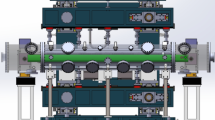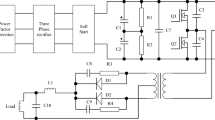Abstract
Background
High energy photon source (HEPS) is the fourth-generation light source, which uses a large number of high-performance insertion devices to generate synchrotron radiation. The control system is an important part of the insertion device (ID).
Purpose
Cryogenic permanent magnet undulator (CPMU) is one kind of IDs that works in liquid nitrogen temperature and ultra-high vacuum environment, and its control system is more difficult and complex than in-air ID. The design of the control system for CPMU will be introduced in detail.
Method
The sub-systems include high-precision magnetic gap control, safety protection, measurement and compensation of magnetic gap at cryogenic temperature and cryogenic temperature monitoring. Mature, reliable, stable technical schemes are designed to meet the technical specifications of sub-systems.
Results
The experiment results show that the magnetic gap motion accuracy can be controlled within 0.2–0.3 μm under the step size of 1 μm. The safety protection system has been tested in turn, and the predetermined protection can be achieved. The average value of magnetic gap cold contraction is 1.512 mm measured by optical micrometer, and the compensation is realized by software. The average temperature of the main magnet structure measured by the temperature sensors is 81.0 K, and the temperature gradient is 0.7 K/m. The temperature monitoring is reliable and stable.
Conclusion
The CPMU control system which is based on EPICS has been successfully applied to the CPMU prototype, and the test results have met the design specifications.





Similar content being viewed by others
References
X. Jiang, J.Q. Wang, Q. Qin et al., Chinese high energy photon source and the test facility. Sci. Sin. Phys. Mech. Astron. 44(10), 1075 (2014)
H.H. Lu, et al., Development of a Prfeb cryogenic permanent magnet undulator (CPMU) prototype at IHEP, in Proceeding of the IPAC17, 8th International Particle Accelerator Conference, May 14–19, 2017, Copenhagen, Denmark, TUPAB064 (2017)
C. Kitegi, Development of a Cryogenic Permanent Magnet Undulator at the ESRF. Université Joseph Fourier (2009)
S. Karabekyan, R. Pannier, J. Pflüger, N. Burandt, J. Kuhn, A. Schöps, The local control system of an undulator cell for the European XFEL, in Proceedings of ICALEPCS2011, Grenoble, France
A.J. Rose, S.C. Lay, A.I. Bell, M.T. Heron, Permanent magnet incertion device control on DIAMOND, in Proceedings of PCaPAC08, Ljubljana, Slovenia
J. Zhang, Q. Zhou, J. Zhuo, Local control system of the elliptically polarized undulator at SSRF. IEEE Trans. Appl. Supercond. 20(3), 332–335 (2010)
J. Chavanne, et al., Magnetic measurement of a cryogenic permanent magnet undulator (CPMU), in IMMW 16, PSI, October 2009
Author information
Authors and Affiliations
Corresponding author
Rights and permissions
About this article
Cite this article
Zhao, S., Cao, J., Lu, H. et al. Control system for cryogenic permanent magnet undulator (CPMU) of high energy photon source (HEPS). Radiat Detect Technol Methods 5, 117–121 (2021). https://doi.org/10.1007/s41605-020-00227-4
Received:
Revised:
Accepted:
Published:
Issue Date:
DOI: https://doi.org/10.1007/s41605-020-00227-4
Keywords
- HEPS
- Cryogenic permanent magnet undulator (CPMU)
- Control system
- High-precision magnetic gap control
- EPICS




